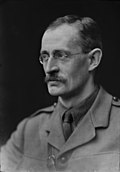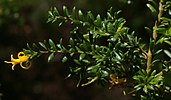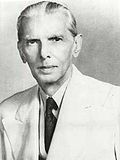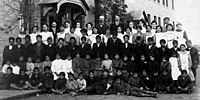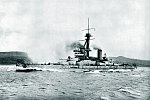Wikipedia:Today's featured article/December 2017
| << | Today's featured articles for December 2017 | >> | ||||
|---|---|---|---|---|---|---|
| Su | Mo | Tu | We | Th | Fr | Sa |
| 1 | 2 | |||||
| 3 | 4 | 5 | 6 | 7 | 8 | 9 |
| 10 | 11 | 12 | 13 | 14 | 15 | 16 |
| 17 | 18 | 19 | 20 | 21 | 22 | 23 |
| 24 | 25 | 26 | 27 | 28 | 29 | 30 |
| 31 | ||||||
December 1
The Beringian wolf (a subspecies of Canis lupus) lived during the last Ice Age in what is now Alaska, the Yukon, and northern Wyoming. The wolf was more robust, with stronger jaws and teeth, than other Late Pleistocene gray wolves and the comparably sized modern Yukon wolf (Canis lupus pambasileus), but not as strong as the dire wolf. The unique adaptation of the skull and dentition of the Beringian wolf allowed it to produce relatively large bite forces, grapple with large struggling prey, and therefore to predate and scavenge on Pleistocene megafauna. The wolf has been comprehensively studied, yielding new information on the prey species and feeding behavior of prehistoric wolves. The Beringian wolf preyed most often on horse and steppe bison, and also on caribou, mammoth, and woodland musk ox. The species survived well into the Holocene before its extinction at the close of the Ice Age, when cold and dry conditions abated and much of its prey also went extinct. The remains of ancient wolves with similar skulls and dentition have been found in western Beringia (north-east Siberia). (Full article...)
December 2
Chicago Pile-1 was the world's first artificial nuclear reactor. Its construction was part of the Manhattan Project, the Allied effort to create atomic bombs during World War II. It was built by the project's Metallurgical Laboratory at the University of Chicago, under the west viewing stands of the original Stagg Field. The first human-made self-sustaining nuclear chain reaction was initiated there on 2 December 1942, supervised by Enrico Fermi, who described the apparatus as "a crude pile of black bricks and wooden timbers". It contained 45,000 graphite blocks weighing 400 short tons (360 t) used as neutron moderators, and was fueled by 6 short tons (5.4 t) of uranium metal and 50 short tons (45 t) of uranium oxide. In the pile, some of the free neutrons produced by the natural decay of uranium were absorbed by other uranium atoms, causing nuclear fission of those atoms, and the release of additional free neutrons. Unlike most subsequent nuclear reactors, it had no radiation shielding or cooling system as it only operated at very low power – about one-half watt. The site is now a National Historic Landmark. (Full article...)
December 3
The American Arts Commemorative Series medallions are gold bullion pieces that were produced by the United States Mint from 1980 to 1984. They were sold to compete with the South African Krugerrand and other bullion coins. The series was proposed by North Carolina Senator Jesse Helms after the US Department of the Treasury began selling portions of the national stockpile of gold. At the suggestion of Iowa Representative Jim Leach, the medallions depict Americans notable for their achievements in the arts. President Jimmy Carter signed the authorization into law in November 1978, despite objections from Treasury officials. The medallions were initially sold through mail order; purchasers were required to obtain the day's price by telephone before ordering. Later, the Mint sold them through telemarketing. Mintage ceased after the ten designs approved by Congress were produced. All were struck at the West Point Bullion Depository. The series sold poorly; critics blamed the complicated process by which they were first marketed, and the fact that they were medallions rather than coins. (Full article...)
December 4
Typhoon Omar of 1992 was the strongest and most destructive typhoon to strike Guam since Typhoon Pamela in 1976. It formed on August 23 from the monsoon trough across the western Pacific Ocean, and made landfall on Guam five days later with winds of 195 km/h (120 mph). The storm caused damage there costing US$457 million, and one death. Strong gusts up to 248 km/h (154 mph) left nearly the entire island without power, disrupting the water system for several days and preventing the island-based Joint Typhoon Warning Center from issuing advisories for 11 days. The storm damaged or destroyed 2,158 houses, leaving 3,000 people homeless. The next day Omar became a super typhoon with sustained winds of 240 km/h (150 mph). Passing well north of the Philippines, it killed 11 people. It weakened significantly before striking eastern Taiwan on September 4; scattered flooding caused three deaths, along with damage worth $65 million, mostly to agriculture. The storm proceeded into eastern China the next day and dissipated on September 9. (Full article...)
December 5
The yellowhammer (Emberiza citrinella) is a Eurasian bird in the bunting family that has been introduced to New Zealand, Australia, South Africa, and the Falkland Islands. The male has a bright yellow head, streaked brown back, chestnut rump and yellow underparts. Other plumages are duller versions of the same pattern. The yellowhammer is common in open areas with some shrubs or trees, and forms small flocks in winter. The song is very similar to that of its closest relative, the pine bunting, with which it interbreeds. Two or three times a year, the female lays 3–5 eggs patterned with a mesh of fine dark lines in a cup nest. The bird's diet is mainly seeds, supplemented by invertebrates in the breeding season. The nest may be raided by rodents or by birds in the crow family, and the adults are hunted by birds of prey. Changes to agricultural practices have led to population declines in western Europe, but the species has a huge range and is not threatened. This conspicuous yellow bird has inspired poems by Robbie Burns and John Clare, and its song has influenced works by Beethoven and Messiaen. (Full article...)
December 6
The Halifax Explosion was a maritime disaster in Halifax, Nova Scotia, Canada, on the morning of 6 December 1917. SS Mont-Blanc, a French cargo ship laden with high explosives bound for Bordeaux, France, collided with the Norwegian vessel SS Imo in the Narrows, at the north-west tip of Halifax Harbour. When a fire on board the French ship ignited her cargo, around 2,000 people were killed by the blast, debris, fires and collapsed buildings, and an estimated 9,000 others were injured. Nearly all structures within an 800-metre (half-mile) radius, including the entire community of Richmond, were obliterated. A pressure wave snapped trees, bent iron rails, demolished buildings, grounded vessels, and scattered fragments of Mont-Blanc for kilometres. A tsunami created by the blast wiped out the community of Mi'kmaq First Nations people who had lived in the Tufts Cove area for generations. The blast was the largest man-made explosion prior to the development of nuclear weapons, releasing the equivalent energy of roughly 2.9 kilotons of TNT (12,000 GJ). There are several memorials to the victims of the explosion in the North End of Halifax. (Full article...)
December 7
"Habits (Stay High)" is a song recorded by Swedish singer Tove Lo, self-released as a single in March 2013, and re-released on 6 December 2013 by Universal Music. It appeared on her debut extended play, Truth Serum, and was the lead single from her debut studio album, Queen of the Clouds. Written by Lo and its producers, Ludvig Söderberg and Jakob Jerlström, it is an electropop song featuring a minimal and upbeat electronic instrumentation. The lyrics describe the singer's attempts to forget her previous boyfriend through substance abuse, drinking and other hedonistic practices. The song was well received by most critics, who commended its lyrics and production. It sold over 2.6 million copies in the United States and peaked at number three on the Billboard Hot 100, the highest position on that chart by a Swedish artist since "The Sign" by Ace of Base (1994). The track topped the charts in Poland and Romania, and peaked within the top ten in many countries. The single was named Song of the Year at the 2015 Grammis Awards in Sweden. (Full article...)
December 8
Ian Johnson (8 December 1917 – 9 October 1998) was an Australian cricketer who played 45 Test matches as a slow off-break bowler between 1946 and 1956. He was on Don Bradman's Invincibles team, which went undefeated on their tour of England in 1948. Johnson captured 109 Test wickets at an average of 29.19 runs per wicket and as a lower order batsman made 1,000 runs at an average of 22.92 runs per dismissal. He captained the Australian team in 17 Tests, winning seven and losing five, including two consecutive losses in the Ashes series against England. Urbane, well-spoken and popular with his opponents and the public, he was seen by his teammates as a disciplinarian, and his natural optimism was often seen as naive. After retirement, Johnson worked for a time as a sports commentator, and covered the 1956 Summer Olympics in Melbourne. In 1957 he was appointed Secretary of the Melbourne Cricket Club, remaining in the role for 26 years. In 1982 he was made a Commander of the Order of the British Empire for services to cricket. (Full article...)
Part of the Australian cricket team in England in 1948 featured topic.
December 9
Air Mata Iboe ('"A Mother's Tears") is a 1941 film from the Dutch East Indies (now Indonesia) directed and written by Njoo Cheong Seng. Starring Fifi Young, Rd Ismail, Ali Sarosa, and Ali Joego, it follows a mother who raises her children lovingly but is ultimately betrayed by her wealthy eldest sons, who refuse to take her in when she falls on hard times. Unwilling to burden her destitute daughter, she depends on the kindness of strangers. The black-and-white film, billed as a musical extravaganza, features a soundtrack by R. Koesbini, and an eponymous title song written by Njoo. Eleven keroncong songs (a folk style with Portuguese influences) were written by music director R. Koesbini, who also appeared in the film. The last production completed by Fred Young's Majestic Film Company, Air Mata Iboe was released in December 1941, shortly before the Japanese occupation of the Dutch East Indies. This film, now possibly lost, received positive reviews. Young retook her role in a remake produced under the same title in 1957. (Full article...)
December 10
The Convention of 1833, a political gathering of settlers in Mexican Texas, was one in a series of unsuccessful attempts at political negotiation that eventually led to the Texas Revolution. It followed the Convention of 1832, whose resolutions had not been addressed by the Mexican government. Delegates met in San Felipe de Austin to draft a series of petitions, with the volatile William H. Wharton presiding. Although the convention's agenda largely mirrored that of the Convention of 1832, delegates also agreed to pursue independent statehood for the province, which was at the time part of the state of Coahuila y Tejas. Under the guidance of Sam Houston, former governor of the US state of Tennessee, a committee drafted a state constitution to submit to the Mexican Congress. Stephen F. Austin (pictured) journeyed to Mexico City to present the petitions to the government. Frustrated with the lack of progress, in October Austin wrote a letter encouraging Texans to form their own state government. This letter was forwarded to the Mexican government, and Austin was imprisoned in early 1834. (Full article...)
December 11
Nigel (c. 1100 – 1169) was Treasurer of England under King Henry I, before being appointed to the see, or bishopric, of Ely in 1133. Nigel owed his advancement to his uncle, Roger of Salisbury, a bishop and government minister. Following the accession of Henry I's successor, King Stephen, Nigel remained as treasurer only briefly. He rebelled and deserted to Stephen's rival Matilda, and never regained high office under Stephen. On the king's death, Nigel was returned to the treasurership by the new king, Henry II. In Nigel's second tenure as treasurer, he returned the administration to the practices of Henry I. He withdrew from much of his public work after around 1164, following an attack of paralysis. He was succeeded as treasurer by his son, Richard fitzNeal, whom he had trained in the operations of the Exchequer, or Treasury of England. Most historians have felt that Nigel's administrative abilities were excellent; he is considered to have been more talented as an administrator than as a religious figure. (Full article...)
December 12
William Beach Thomas (1868–1957) was a British author and journalist who worked as a war correspondent and wrote about nature and country life. After a short-lived career as a schoolmaster, he began to write articles for newspapers and periodicals, as well as books. During the early part of the First World War he defied military authorities by reporting news stories from the Western Front for his employer, the Daily Mail. He was briefly imprisoned before being granted official accreditation as a war correspondent. His book With the British on the Somme (1917) portrayed the English soldier in a very favourable light. Both France and Britain rewarded him with knighthoods after the war, but Beach Thomas regretted some of his wartime output. His primary interest as an adult was in rural matters. He was an advocate for the creation of national parks in England and Wales, and mourned the decline of traditional village society. He wrote extensively, particularly for The Observer newspaper and The Spectator, a conservative magazine. His book The English Landscape (1938) includes selections from his contributions to Country Life magazine. (Full article...)
December 13
Nights: Journey of Dreams is an action video game developed by Sonic Team and published by Sega for the Wii. The sequel to the 1996 Sega Saturn title Nights into Dreams, it was first released in Japan, on 13 December 2007, followed by North America, Australia and Europe. The story follows two children, Will and Helen, who enter a dream world called Nightopia. When their nightmares come to life, they enlist the flying character Nights to help them stop the evil ruler Wizeman from escaping into the real world. The main objective of the game is to fly through rings while gathering keys to access new levels. The game's setting was designed to resemble England, especially parts of London. Development of Journey of Dreams began shortly after the release of Shadow the Hedgehog in 2005, and was headed by Sonic Team veteran Takashi Iizuka. The game received mixed reviews; critics praised its colourful visuals, boss battles and special effects, but most cited its poor control schemes, aesthetics and general gameplay as major flaws. (Full article...)
December 14
Morihei Ueshiba (December 14, 1883 – April 26, 1969) was the founder of the Japanese martial art of aikido. The son of a landowner from Tanabe, he studied martial arts in his youth, and served in the Japanese Army during the Russo-Japanese War. In 1907 he moved to Hokkaidō as the head of a pioneer settlement and studied with Takeda Sōkaku, the founder of Daitō-ryū Aiki-jūjutsu. In 1919 Ueshiba joined the Ōmoto-kyō movement, a Shinto sect, in Ayabe, and opened his first dojo. He accompanied the head of the group, Onisaburo Deguchi, on an expedition to Mongolia in 1924, where they were captured by Chinese troops and returned to Japan. Moving to Tokyo in 1926, he set up the Aikikai Hombu Dojo. He taught at this dojo and others around Japan, including several military academies. After World War II he retired to Iwama, and continued training at a dojo he had set up there. He continued to promote aikido throughout Japan and abroad until the 1960s. Many of his students became noted martial artists in their own right, and aikido is now practiced around the world. (Full article...)
December 15
The Hawker Hurricane fighter aircraft was in Yugoslav service from 1938 to 1941 and 1944 to 1951. The Royal Yugoslav Air Force obtained 24 of the British fighters commencing on 15 December 1938 from early production batches, the first foreign sale of the aircraft. Twenty additional fighter aircraft were built by Zmaj under licence in Yugoslavia. When the country was drawn into World War II by the German-led Axis invasion of April 1941, the aircraft achieved some successes against the Luftwaffe, but all the Yugoslav Hurricanes were destroyed or captured during the 11-day invasion. In mid-1944, the Yugoslav Partisans formed two Royal Air Force squadrons, Nos. 351 and 352, which both operated Hurricane fighter-bombers. No. 351 Squadron flew Hurricane Mk IICs during training and was later equipped with Hurricane Mk IVs, and No. 352 briefly flew Hurricane Mk IICs during training before re-equipping with Supermarine Spitfire Mk Vs. Both squadrons operated as part of No. 281 Wing RAF of the Balkan Air Force, conducting ground attack missions in support of the Partisans. Hurricanes remained in service with the post-war Yugoslav Air Force until the early 1950s. (Full article...)
December 16
Portman Road is an association football stadium in Ipswich, Suffolk, England. It has been the home ground of Ipswich Town Football Club since 1884. The stadium has also hosted many England youth international matches, and one senior England international exhibition game, against Croatia in 2003. It has staged several other sporting events, including athletics meetings and international field hockey matches. In addition, musical concerts and Christian events have been held at the ground. The stadium underwent significant redevelopments in the early 2000s, which increased the capacity from 22,600 to a current figure of 30,311, making it the largest capacity football ground in East Anglia. Each of its four stands have since been converted to all-seater (eliminating standing-room only tickets), following the recommendations of the Taylor Report. Also located at the ground are conference and banqueting facilities, the Sir Bobby Robson Suite, and Legends Bar. (Full article...)
Part of the Ipswich Town F.C. featured topic.
December 17
Persoonia terminalis, the Torrington geebung, is a rare shrub belonging to the family Proteaceae, and native to northern New South Wales and southern Queensland in eastern Australia. Reported as a subspecies of Persoonia nutans in 1981, it was described as a species by Lawrie Johnson and his colleague Peter Weston in 1991. Two subspecies—P. t. terminalis and P. t. recurva—are recognised; both are found on well-drained acidic soils in sclerophyll forests, and P. t. terminalis is also found on granite outcrops. Although similar in appearance, they differ in leaf length and curvature. Both have a restricted range, with P. t. terminalis found in an area of under 100 square kilometres (39 square miles). P. terminalis grows to 1.5 metres (5 feet), with an upright or spreading habit, and narrow, short leaves up to 1 centimetre (0.4 inches) in length. The yellow flowers mainly appear in December and January (Australia's temperate zone summer), and are followed by purple-striped green drupes (stone fruit). The fruit of persoonias are edible, and dispersed by wild vertebrates. (Full article...)
December 18
Galaxy Science Fiction was an American digest-size science fiction magazine, published from 1950 to 1980. It was founded by World Editions and sold two years later to Robert Guinn, the magazine's printer. Its first editor, H. L. Gold, rapidly made Galaxy the leading science fiction magazine of its time, focusing on stories about social issues rather than technology, including Ray Bradbury's "The Fireman" (later expanded as Fahrenheit 451), Robert A. Heinlein's The Puppet Masters, and Alfred Bester's The Demolished Man. Frederik Pohl, who had been doing most of the production work for some time, took over as editor officially in 1961. Until his departure in 1969, Galaxy had continued success, regularly publishing fiction by writers such as Cordwainer Smith, Jack Vance, Harlan Ellison, and Robert Silverberg. At its peak, Galaxy greatly influenced the science fiction field. Gold brought a "sophisticated intellectual subtlety" to magazine science fiction, according to Pohl. Historian David Kyle suggests that Gold's new direction led to the experimental New Wave, the defining science fiction literary movement of the 1960s. (Full article...)
December 19
Chad Harris-Crane is a fictional character on the American soap opera Passions, which aired on NBC from 1999 to 2007 and on DirecTV in 2007–08. Developed by the soap's creator and head writer James E. Reilly, Chad was portrayed by Donn Swaby (1999 to 2002) and Charles Divins (2002 to 2007). The son of the evil patriarch Alistair Crane of the Crane family, Chad becomes involved in a love triangle with the sisters Whitney and Simone Russell. He is initially believed to be Whitney's half-brother, but is revealed to be her adoptive cousin. His later storylines focus on his confusion over his sexual identity; his relationship with tabloid reporter Vincent Clarkson includes a depiction of the two men having sex, the first such scene in any daytime soap opera. Chad attempts to reconcile with Whitney before being killed by Alistair. Critical response to Chad was mixed; some reviewers praised the handling of the incest storyline and the representation of LGBT characters of color on daytime television, while others criticized his relationship with Vincent as an irresponsible representation of racial and sexual identity. (Full article...)
Part of the Russell family (Passions) featured topic.
December 20
The Guilden Morden boar is a sixth- or seventh-century Anglo-Saxon copper alloy figure of a boar that may have once served as the crest of a helmet. It was found around 1864 or 1865 in a grave in the village of Guilden Morden in Cambridgeshire. Herbert George Fordham, whose father discovered the boar, donated it to the British Museum in 1904, where it is now displayed. It is simply designed, with a prominent mane; eyes, eyebrows, nostrils and tusks are only faintly present. A pin and socket design formed by the front and hind legs suggests that the boar was mounted on another object, such as a helmet. Boar-crested helmets are a staple of Anglo-Saxon imagery, evidence of a Germanic tradition in which the boar invoked the protection of the gods. They may have been common, and in the Anglo-Saxon poem Beowulf, boar-adorned helmets are mentioned five times. The Guilden Morden boar is one of three known to have survived to the present, together with the ones on helmets from Benty Grange and Wollaston. (Full article...)
December 21
Musca (fly) is a small constellation in the deep southern sky. It was one of twelve constellations created by Petrus Plancius from the observations of Pieter Dirkszoon Keyser and Frederick de Houtman, first appearing on a 35-centimetre (14-inch) diameter celestial globe by Plancius and Jodocus Hondius published in 1597 or 1598 in Amsterdam. The first depiction in a celestial atlas was in Johann Bayer's Uranometria of 1603. Musca remains below the horizon for most Northern Hemisphere observers. Many of the constellation's brighter stars are in the Scorpius–Centaurus Association, hot blue-white stars that appear to share a common origin and motion across the Milky Way. These include Alpha, Beta, Gamma, Zeta2 and (likely) Eta Muscae, as well as HD 100546, a blue-white Herbig Ae/Be star that is surrounded by a complex debris disk containing a large planet or brown dwarf and possible protoplanet. Two further star systems have been found to have planets. The constellation also contains two Cepheid variables visible to the naked eye. Theta Muscae is a triple star system, the brightest member of which is a Wolf–Rayet star. (Full article...)
December 22
Blast Corps is an action video game for the Nintendo 64, released worldwide on December 22, 1997, in which the player uses vehicles to destroy buildings in the path of a runaway nuclear missile carrier. Through the game's 57 levels, the player solves puzzles by moving objects and bridging gaps with the vehicles. The game was developed at Rare by a small team of recent graduates over the course of a year. They were inspired, in part, by the puzzle elements of Donkey Kong (1994). Nintendo published and released Blast Corps to critical acclaim in March 1997 in Japan and North America, with a wider release at the year's end. The game received several editor's choice awards and Metacritic's second highest Nintendo 64 ratings of 1997, but sold below the team's expectations at one million copies. Reviewers praised the game's originality, variety, and graphics, but some critiqued its controls and repetition. Reviewers of the 2015 Rare Replay retrospective compilation noted Blast Corps as a standout title. (Full article...)
December 23
Mortimer Wheeler (1890–1976) was a British archaeologist and army officer who served as Director of the National Museum of Wales and the London Museum, headed the Archaeological Survey of India, and wrote twenty-four books on archaeology. He argued that excavation and the recording of stratigraphic context required an increasingly scientific and methodical approach, developing the "Wheeler Method". In 1934, he established the Institute of Archaeology as part of the federal University of London, becoming its Honorary Director and overseeing excavations of the Roman sites at Lydney Park and Verulamium and the Iron Age hill fort of Maiden Castle. During World War II, he rose to the rank of brigadier, serving in the North African Campaign and the Allied invasion of Italy. In India, he oversaw excavations of sites at Harappa, Arikamedu, and Brahmagiri. In later life, his popular books, cruise ship lectures, and appearances on radio and television, particularly the BBC series Animal, Vegetable, Mineral?, helped to bring archaeology to a mass audience. Appointed Honorary Secretary of the British Academy, he raised large sums of money for archaeological projects. (Full article...)
December 24
The American Bible Challenge (2012–2014) is a Biblical-themed American television game show created by Game Show Network. The series is hosted by Jeff Foxworthy (pictured), joined by Kirk Franklin in the second season. Each season of the series is played as a nine-episode tournament with six episodes of opening rounds, two semi-finals, and a final. Each opening round starts with three teams of three contestants answering questions about the Bible. One contestant from each team participates in the following round. The two highest-scoring teams compete in a final one-minute round, and a $20,000 prize is donated to a charity of the winning team's choice. Over the course of the season, winning teams advance to semi-final games and then to a final game with a grand prize of $100,000, for a total possible payout of $140,000 for the season winner's charity. The show became GSN's highest rated original program in the history of the network. In 2014, the show received a nomination at the 41st Daytime Emmy Awards for Outstanding Game Show, and Foxworthy was nominated as Outstanding Game Show Host. (Full article...)
December 25
Muhammad Ali Jinnah (25 December 1876 – 11 September 1948) is honoured as the founder of Pakistan, where his birthday is observed as a national holiday. He served as leader of the All-India Muslim League from 1913 until Pakistan's independence from Great Britain in 1947, and then as the first Governor-General of Pakistan until his death. Jinnah rose to prominence in the Indian National Congress in the first two decades of the 20th century. In these early years of his political career, he advocated Hindu–Muslim unity, helping to shape the 1916 Lucknow Pact between the Congress and the All-India Muslim League. By 1940, he had come to believe that Muslims of the Indian subcontinent should have their own state. As the first leader of Pakistan, he worked to establish the nation's government and policies, and to aid the millions of Muslim migrants who had emigrated from the new nation of India to Pakistan after independence, personally supervising the establishment of refugee camps. Several universities and public buildings in Pakistan bear Jinnah's name. (Full article...)
December 26
The Canadian Indian residential school system was a network of boarding schools for Indigenous children who were removed from their families and culture to be assimilated into Canadian culture. It was funded by the government's Department of Indian Affairs, in keeping with the Indian Act of 1876, and administered by various churches. Over more than a century about 30 percent of Indigenous children (roughly 150,000) were placed in residential schools, where at least 6,000 of them died. The schools were intentionally located far away from home communities, and parental visits were further restricted by a pass system that confined Indigenous peoples to reserves. Students often graduated unable to fit into either their home communities or Canadian society, and impacted families have suffered disproportionately from post-traumatic stress, alcoholism, substance abuse, and suicide. The last federally operated residential school closed in 1996. The 2015 findings of the Truth and Reconciliation Commission concluded that the system amounted to cultural genocide. (Full article...)
December 27
São Paulo was a dreadnought battleship in the Brazilian Navy, the second of two ships in the Minas Geraes class. Launched in 1909 and commissioned a year later, São Paulo was soon involved in the Revolt of the Lash, in which crews on four Brazilian warships mutinied over poor pay and harsh punishments for even minor offenses. In 1922 the ship attacked a fort that had been taken during the Tenente revolts. Two years later, mutineers took control of the ship and sailed to Montevideo where they obtained asylum. In the 1930s, São Paulo was passed over for modernization. When Brazil entered the Second World War, the ship sailed to the port of Recife and remained there as the port's main defense for the duration of the war. Stricken from the naval register in 1947, the dreadnought remained as a training vessel until 1951, when it was taken under tow to be scrapped in the United Kingdom. The tow lines broke during a strong gale in November when the ships were 150 nmi (280 km; 170 mi) north of the Azores, and São Paulo was lost. (Full article...)
Part of the Minas Geraes-class battleships featured topic.
December 28
Leelah Alcorn (November 15, 1997 – December 28, 2014) was an American transgender girl whose suicide attracted international attention. At age 14, she came out as transgender to her parents, and at 16, she asked to undergo transition treatment; instead, they sent her to conversion therapy. After she revealed her attraction toward males to her classmates, her parents removed her from school and revoked her access to social media. She killed herself by walking into highway traffic. In her suicide note, Alcorn blamed her parents for her loneliness and alienation, and asked people to pay more attention to discrimination and abuse faced by transgender youth. LGBT rights activists cited the incident as evidence of the problems she wrote about, and vigils were held in her memory. Petitions that called for the establishment of "Leelah's Law", a ban on conversion therapy in the U.S., received a supportive response from President Barack Obama. Within a year, her hometown of Cincinnati, Ohio, criminalized conversion therapy. (Full article...)
December 29
Qatna is an ancient city in Syria whose remains are about 18 km (11 mi) northeast of Homs near the village of al-Mishrifeh. It was an important center in the second millennium BC and in the first half of the first millennium BC, with one of the largest royal palaces of Bronze Age Syria. An intact royal tomb has provided data on the funerary habits of that period. First inhabited in the second half of the fourth millennium BC, it was repopulated around 2800 BC and continued to grow. Around 2000 BC, it became the capital of a regional kingdom that spread its authority over the central and southern Levant. By the 15th century BC, Qatna had lost its hegemony and was under the authority of Mitanni. It was conquered and sacked by the Hittites in the late 14th century BC and abandoned by the 13th century BC. It was re-inhabited in the 10th century BC, becoming a center of the kingdoms of Palistin and Hamath until it was destroyed by the Assyrians in 720 BC, eventually disappearing in the 6th century BC. The site has been excavated since the 1920s. As a result of the Syrian Civil War, excavations stopped in 2011. (Full article...)
December 30
William Borah (1865–1940) was an outspoken Republican United States Senator from the state of Idaho. A progressive who served in the Senate from 1907 until his death, he is often considered an isolationist. He reluctantly voted for U.S. entry into World War I in 1917 and, once the war ended, fought successfully against Senate ratification of the Treaty of Versailles, which would have made the U.S. part of the League of Nations. Remaining a maverick, he often fought with the Republican presidents in office between 1921 and 1933, though Coolidge offered to make Borah his running mate in 1924. Deprived of his post as Chairman of the Senate Foreign Relations Committee when the Democrats took control in 1933, Borah supported some New Deal legislation, but opposed other proposals. In his final years, he felt he might be able to settle differences in Europe by meeting with Hitler; though he did not go, this has not enhanced his historical reputation. His statue, presented by the state of Idaho in 1947, stands in the National Statuary Hall Collection. (Full article...)
December 31
The birthday-number effect is the unconscious tendency of people to prefer the numbers in the date of their birthday over other numbers. First reported in 1997 by Japanese psychologists Shinobu Kitayama and Mayumi Karasawa, the birthday-number effect has been shown to hold across age and gender. The effect is most prominent for numbers over 12. Birth dates are unconsciously associated with the self, and most people like themselves; this has been offered as an explanation for the effect. Conversely, people who do not like themselves tend not to exhibit the effect. One lab study revealed an increase in favourable attitudes towards prices that were secretly manipulated to match the day of the month of the subjects’ birth, but a second study using birth year as price did not lead to the same result. People also have an unconscious preference for the letters in their name, and the two effects are significantly correlated. Another study found that participants with high self-esteem tended to prefer product names that included numbers from their birthday along with letters from their name. (Full article...)










